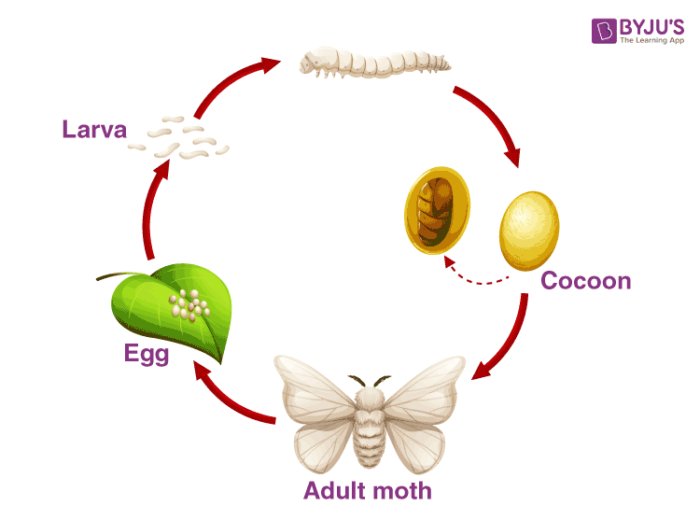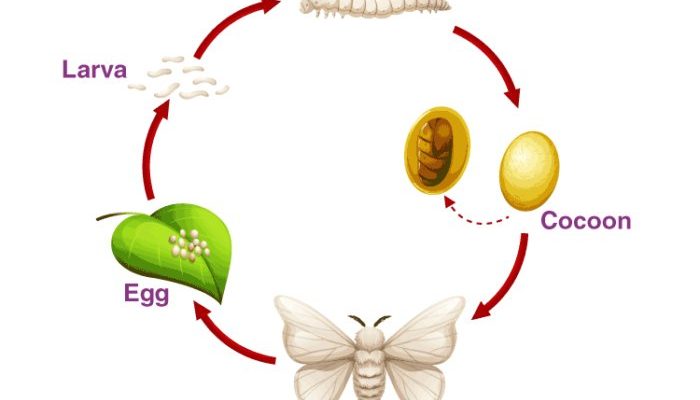
To kick things off, silkworms are more than just insects; they play a vital role in producing silk. They’re the larvae of the Bombyx mori moth, and their lifecycle is a series of stages that showcases nature’s wonders. Think of it like a play with different acts, where each act reveals something new about these remarkable creatures.
Stage 1: Egg – The Beginning
Let’s start at the very beginning: the egg stage. The female moth lays about 300 to 500 tiny, shiny eggs. Picture these eggs as little pearls, each one packed with potential. They’re tiny—about the size of a pinhead—and can be either white or yellow. A little fun fact: the eggs need to be kept in a warm, humid environment, similar to what you’d find in a cozy greenhouse.
After about 10 days, under the right conditions, those eggs hatch into adorable little larvae known as silkworms. They emerge ready to munch, and boy do they eat! You might be wondering what their diet looks like. Well, silkworms primarily feed on mulberry leaves. They’re like kids in a candy store, consuming as much foliage as they can. It’s essential for their growth and development, as they need to store energy for the next phase of their lifecycle.
Stage 2: Larval Stage – The Growing Phase
Once the silkworms hatch, they enter the larval stage. This is where the transformation really begins. Over the next 4 to 6 weeks, they go through 5 molts, which means they shed their skin multiple times. It’s an exciting time for them, akin to a teenager going through growth spurts. With each molt, they become larger and hungrier.
During this stage, silkworms can consume up to 40,000 times their body weight! That’s a serious amount of food. Their main focus is on eating and growing. The ideal temperature for their growth is around 25°C (77°F), and the right humidity plays a huge role as well. If you think about it, keeping them comfortable during this stage is crucial for the silk production process.
As they grow, you’ll notice their bodies becoming plumper. This is when they start building up the energy needed for the next big step in their lives. Honestly, it’s like waiting for a butterfly to emerge from a chrysalis, except silkworms are preparing to create silk instead.
Stage 3: Cocoon Formation – The Transformation
After the larval stage, it’s time for a significant change. The silkworms stop eating and begin spinning their cocoons. This is a critical point in their lifecycle. They create a protective casing using a silk thread that can be up to several hundred meters long. Imagine this as their personal safe space.
The inside of the cocoon is where the magic happens. The silkworm will transform into a pupa. This process can take about 2 to 3 weeks. Inside the cocoon, their bodies are breaking down and reconfiguring into a moth, much like a caterpillar that morphs into a butterfly. It’s a fascinating process of metamorphosis, isn’t it?
Here’s the thing: not all cocoons lead to the emergence of moths. Some are harvested for silk production, which means they never get to complete the cycle. This is often a point of concern for many who love nature and want to protect these creatures. The balance between silk production and sustainability is essential.
Stage 4: Pupa – The Waiting Game
While inside the cocoon, silkworms enter the pupal stage. It’s a bit like being in a cozy hotel for some time; they won’t see the outside world yet, but they’re getting ready for their grand entrance. The pupa doesn’t eat or move much during this phase. It’s all about transformation now—changing from a silkworm into a moth.
This stage can last anywhere from 10 to 14 days. Inside, their bodies are developing wings, legs, and antennae. You know, if you’ve ever waited for something exciting, you can relate to the anticipation these little ones feel. There’s a world beyond the cocoon, and soon enough, they’ll be ready to explore it.
If you’re curious about how this all happens, it’s driven by hormones and other biological changes. Nature has an incredible way of managing these processes, almost like an orchestra playing in perfect harmony.
Stage 5: Adult Moth – The Grand Finale
Finally, the moment arrives. After spending days hidden away, the adult moth breaks free from its cocoon. It’s a delicate process, and they often take their time breaking out, as they need to pump fluid into their wings to inflate them. Imagine how exhilarating it must feel to finally emerge after all that time!
Adult moths are typically pale yellow or white, and they have beautiful, delicate wings. Their first job is to find a mate, as the cycle begins anew. While they might not eat much as adults, they do rely on stored energy to carry them through this phase.
Interestingly, adult female moths release pheromones to attract males, effectively playing matchmaker in the silkworm world. Once they mate, the cycle starts all over again with the laying of new eggs.
Importance of the Silkworm Lifecycle
Understanding the silkworm lifecycle is essential for a few reasons. First, it highlights an incredible journey of growth and transformation that can inspire us. Second, it emphasizes the importance of sustainability in silk production. As consumers, knowing more about these creatures can guide our choices and promote ethical practices.
Silk is a beautiful material, but it comes with responsibilities. Being mindful of the lifecycle encourages us to support farms and products that prioritize the well-being of these fascinating insects.
If you think about it, the next time you wear a silk garment, you’re not just wearing a piece of fabric; you’re wearing a part of the silkworm’s life story.
In conclusion, the silkworm lifecycle is a remarkable journey filled with growth, transformation, and a touch of magic. From tiny eggs to beautiful adult moths, each stage plays a role in the bigger picture of nature. By understanding their lifecycle, we can appreciate the beauty and value of silk while promoting ethical practices. So, the next time you come across silk, remember the hardworking silkworms behind it all!

